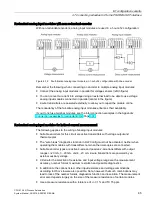
I/O configuration variants
4.7 Connecting redundant I/O to the PROFIBUS DP interface
CPU 410-5H Process Automation
76
System Manual, 09/2014, A5E31622160-AB
4.7
Connecting redundant I/O to the PROFIBUS DP interface
4.7.1
Signal modules for redundancy
Signal modules as redundant I/O
The signal modules listed below can be used distributed as redundant I/O. Note the latest
information on use of the modules in the PCS 7 readme.
Note
The statements on the individual signal modules in this section refer exclusively to their use
in redundant operation. Restrictions and special features listed here especially do not apply
to the use of the corresponding module in stand-alone operation.
Take into account that you can only use modules of the same product version and same
firmware version as redundant pairs.
Note
PROFINET
The use of redundant I/O at the PROFINET interface is not possible.
A complete list of all modules approved for PCS 7 V8.1 is available in the technical
documentation of SIMATIC PCS 7, see Technical documentation.
Table 4- 6
Signal modules for redundancy
Module
Article No.
Redundant DI dual-channel
DI16xDC 24 V, interrupt
6ES7 321-7BH00-0AB0
DI16xDC 24 V
6ES7 321–7BH01–0AB0
In the event of an error on one channel, the entire group (2 channels) is passivated. When using the module with HF index,
only the faulty channel is passivated in the event of a channel error.
Use with non-redundant encoder
•
This module supports the "wire break" diagnostic function. To implement this function, make sure that a total current
between 2.4 mA and 4.9 mA flows even at signal state "0" when you use an encoder that is evaluated at two inputs in
parallel.
You achieve this by connecting a resistor across the encoder. Its value depends on the type of switch and usually
ranges between 6800 and 8200 ohms for contacts.
For BEROS, calculate the resistance based on this formula:
(30 V/(4.9 mA – I_R_Bero) < R < (20 V/(2.4 mA – I_R_Bero)
















































